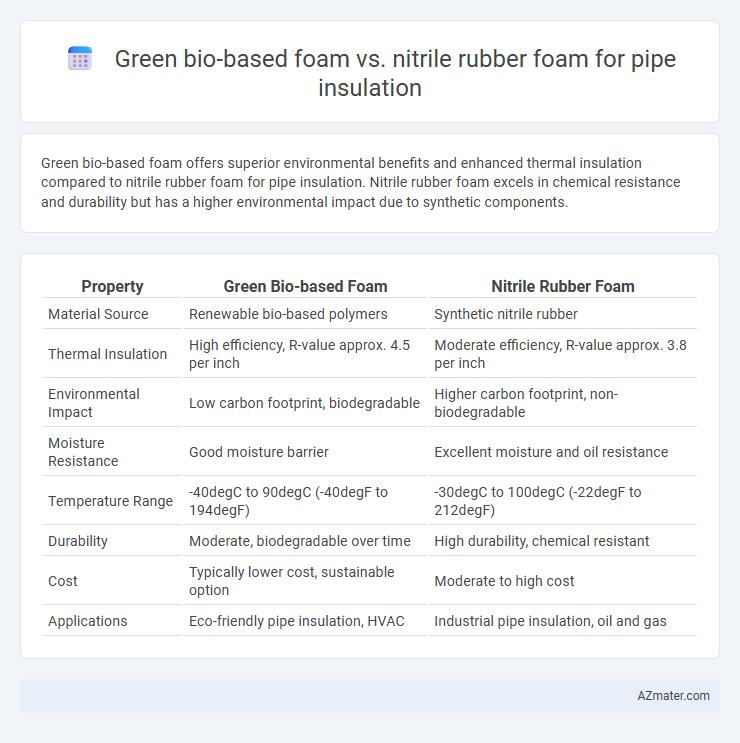Green bio-based foam offers superior environmental benefits and enhanced thermal insulation compared to nitrile rubber foam for pipe insulation. Nitrile rubber foam excels in chemical resistance and durability but has a higher environmental impact due to synthetic components.
Table of Comparison
| Property | Green Bio-based Foam | Nitrile Rubber Foam |
|---|---|---|
| Material Source | Renewable bio-based polymers | Synthetic nitrile rubber |
| Thermal Insulation | High efficiency, R-value approx. 4.5 per inch | Moderate efficiency, R-value approx. 3.8 per inch |
| Environmental Impact | Low carbon footprint, biodegradable | Higher carbon footprint, non-biodegradable |
| Moisture Resistance | Good moisture barrier | Excellent moisture and oil resistance |
| Temperature Range | -40degC to 90degC (-40degF to 194degF) | -30degC to 100degC (-22degF to 212degF) |
| Durability | Moderate, biodegradable over time | High durability, chemical resistant |
| Cost | Typically lower cost, sustainable option | Moderate to high cost |
| Applications | Eco-friendly pipe insulation, HVAC | Industrial pipe insulation, oil and gas |
Introduction to Pipe Insulation Materials
Green bio-based foam and nitrile rubber foam are prominent materials used for pipe insulation due to their thermal resistance and environmental impact. Bio-based foam offers renewable sourcing and biodegradability, reducing carbon footprint in insulation applications. Nitrile rubber foam excels in durability, chemical resistance, and flexibility, making it suitable for extreme temperature conditions and industrial piping systems.
Overview of Green Bio-Based Foam
Green bio-based foam for pipe insulation offers superior environmental benefits due to its renewable raw materials derived from plant-based sources, significantly reducing carbon footprint compared to traditional nitrile rubber foam. This foam provides excellent thermal insulation performance with high resistance to heat, moisture, and chemicals, enhancing energy efficiency in industrial and commercial piping systems. Its biodegradability and lower environmental impact make it a sustainable alternative to nitrile rubber foam, which relies on petrochemical sources and may contribute to long-term ecological concerns.
Overview of Nitrile Rubber Foam
Nitrile rubber foam is a synthetic material widely used for pipe insulation due to its excellent resistance to oil, chemicals, and temperature fluctuations ranging from -40degC to 120degC. Its closed-cell structure provides superior thermal insulation and moisture resistance, making it ideal for industrial and HVAC applications. The foam's flexibility, durability, and fire-retardant properties contribute to its popularity in maintaining energy efficiency and protecting pipes from corrosion and condensation.
Thermal Insulation Performance Comparison
Green bio-based foam exhibits superior thermal insulation properties for pipe insulation due to its lower thermal conductivity, typically ranging between 0.030 to 0.035 W/m*K, compared to nitrile rubber foam, which has thermal conductivity values around 0.035 to 0.040 W/m*K. The bio-based foam's cellular structure enhances heat retention and reduces energy loss, making it more efficient in maintaining temperature stability. Nitrile rubber foam provides good thermal resistance but often underperforms in extreme temperature fluctuations compared to green bio-based alternatives.
Environmental Impact and Sustainability
Green bio-based foam offers superior environmental benefits compared to nitrile rubber foam for pipe insulation, as it is derived from renewable resources, reducing reliance on fossil fuels and decreasing carbon emissions during production. Its biodegradability and lower toxicity contribute to reduced ecological footprints and enhanced sustainability in disposal and recycling processes. Conversely, nitrile rubber foam, although durable and effective in thermal insulation, is petroleum-based with higher greenhouse gas emissions and limited biodegradability, posing challenges for long-term environmental sustainability.
Fire Resistance and Safety Features
Green bio-based foam offers superior fire resistance with low smoke emission and non-toxic fumes compared to nitrile rubber foam, which can release harmful chemicals during combustion. The bio-based foam meets stringent fire safety standards, reducing the risk of flame spread and improving occupant safety in residential and commercial pipe insulation. Nitrile rubber foam, while flexible and durable, generally exhibits lower fire resistance, necessitating additional fire-retardant treatments to comply with safety regulations.
Durability and Longevity
Green bio-based foam for pipe insulation offers enhanced durability through its resistance to microbial growth and environmental degradation, resulting in a longer lifespan compared to traditional materials. Nitrile rubber foam exhibits excellent mechanical strength and resistance to oils, chemicals, and temperature extremes, which contributes to its robust longevity in industrial insulation applications. Both materials provide substantial durability, but green bio-based foam prioritizes eco-friendly sustainability while nitrile rubber foam emphasizes superior resilience under harsh conditions.
Cost Analysis: Initial and Lifecycle
Green bio-based foam for pipe insulation typically has a higher initial cost compared to nitrile rubber foam due to renewable raw materials and sustainable manufacturing processes. Over the lifecycle, bio-based foam can offer cost savings through enhanced thermal insulation and biodegradability, reducing disposal expenses and environmental fees. Nitrile rubber foam tends to have lower upfront prices but may incur higher long-term costs from maintenance, replacement, and environmental compliance.
Installation and Maintenance Considerations
Green bio-based foam offers easier installation due to its lightweight nature and flexible structure, allowing for quick fitting around pipes and minimal use of adhesives. Nitrile rubber foam, while more durable and resistant to oils and chemicals, requires careful handling and precise cutting to maintain its integrity during installation. Maintenance of bio-based foam is generally simpler as it resists mold and mildew naturally, whereas nitrile rubber foam demands regular inspections for cracks or degradation in harsh environments to ensure long-term performance.
Future Trends in Pipe Insulation Technologies
Green bio-based foam for pipe insulation offers enhanced sustainability with lower carbon footprints and improved biodegradability compared to nitrile rubber foam, which is widely used for its durability and chemical resistance. Emerging trends emphasize the integration of renewable materials and advanced thermal insulation properties, driving innovation toward eco-friendly, high-performance foams in industrial applications. Future developments focus on hybrid composites and smart insulation systems that combine bio-based materials with nanotechnology to optimize energy efficiency and environmental impact.

Infographic: Green bio-based foam vs Nitrile rubber foam for Pipe insulation
 azmater.com
azmater.com